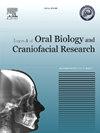通过应力分布分析定量评估下颌第二磨牙颈周牙本质:有限元研究
Q1 Medicine
Journal of oral biology and craniofacial research
Pub Date : 2025-03-11
DOI:10.1016/j.jobcr.2025.02.011
引用次数: 0
摘要
目的应用有限元分析(FEA)对下颌第二初级磨牙的颈周牙本质(PCD)及其在咀嚼负荷下维持结构完整性的作用进行定量分析。通过确定PCD的分布和应力承受能力,我们的目标是推荐维持PCD的治疗方案,以提高儿童牙髓学的抗骨折能力。方法采用锥形束ct (Cone Beam Computed Tomography, CBCT)扫描生成下颌第二初级磨牙的三维模型,并利用有限元分析软件进行分析。在0°、45°和90°的角度上分别施加353.64 N(最大)、169.3 N(平均)和8.05 N(最小)的模拟咀嚼载荷,以表示垂直、侧向和最大咀嚼力。通过测量沿颊、舌、中、远端表面的应力分布来量化PCD。结果分析显示,下颌第二初级磨牙的受力区域从牙髓-牙釉质交界处(CEJ)向冠状面延伸约1-1.5 mm,从CEJ向根状面延伸约1-1.5 mm,形成了PCD的关键3 mm区域。在这个PCD区域内,在牙齿的所有表面上都发现了最高的应力,突出了它对牙齿结构稳定性的重要性。结论对3mm PCD区(CEJ的冠状和根状面)的定量分析强调了其在强化牙齿中的关键作用。基于这些发现,我们建议在儿童牙髓学中保守腔体预备以保存PCD,以避免结构弱化并改善长期临床结果。本文章由计算机程序翻译,如有差异,请以英文原文为准。

Quantitative assessment of pericervical dentin in mandibular second primary molars through stress distribution analysis: A finite element study
Objective
The purpose of this study was to quantify the Pericervical Dentin (PCD) in the mandibular second primary molar and its role in maintaining structural integrity under masticatory loads using Finite Element Analysis (FEA). By identifying the distribution and stress-bearing capacity of PCD, we aim to recommend treatment protocols that maintain PCD to improve fracture resistance in pediatric endodontics.
Methods
A 3D model of a mandibular second primary molar was generated from Cone Beam Computed Tomography (CBCT) scans and analyzed using FEA software. Simulated masticatory loads of 353.64 N (maximum), 169.3 N (mean), and 8.05 N (minimum) were applied at angles of 0°, 45°, and 90° to represent vertical, lateral, and maximum masticatory forces. PCD was quantified by measuring stress distribution along buccal, lingual, mesial, and distal surfaces.
Results
The analysis revealed that the stress-bearing region in the mandibular second primary molar extends approximately 1–1.5 mm from the Cemento-enamel Junction (CEJ) towards the coronal aspect and 1–1.5 mm from the CEJ towards the radicular aspect, creating a critical 3 mm zone of PCD. The highest stress was consistently found within this PCD zone across on all surfaces of the tooth, highlighting its importance for the tooth’s structural stability.
Conclusion
A quantitative analysis of the 3 mm PCD zone (coronal and radicular aspect from the CEJ) emphasizes its critical role in strengthening teeth. Based on these findings, we recommend conservative cavity preparation in pediatric endodontics on preserving PCD to avoid structural weakening and improve long-term clinical outcomes.
求助全文
通过发布文献求助,成功后即可免费获取论文全文。
去求助
来源期刊

Journal of oral biology and craniofacial research
Medicine-Otorhinolaryngology
CiteScore
4.90
自引率
0.00%
发文量
133
审稿时长
167 days
期刊介绍:
Journal of Oral Biology and Craniofacial Research (JOBCR)is the official journal of the Craniofacial Research Foundation (CRF). The journal aims to provide a common platform for both clinical and translational research and to promote interdisciplinary sciences in craniofacial region. JOBCR publishes content that includes diseases, injuries and defects in the head, neck, face, jaws and the hard and soft tissues of the mouth and jaws and face region; diagnosis and medical management of diseases specific to the orofacial tissues and of oral manifestations of systemic diseases; studies on identifying populations at risk of oral disease or in need of specific care, and comparing regional, environmental, social, and access similarities and differences in dental care between populations; diseases of the mouth and related structures like salivary glands, temporomandibular joints, facial muscles and perioral skin; biomedical engineering, tissue engineering and stem cells. The journal publishes reviews, commentaries, peer-reviewed original research articles, short communication, and case reports.
 求助内容:
求助内容: 应助结果提醒方式:
应助结果提醒方式:


